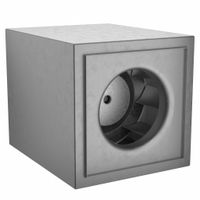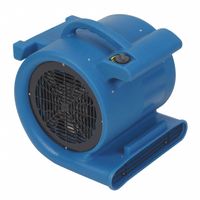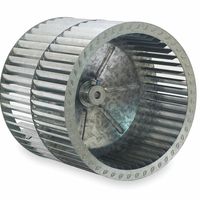Call +(254) 703 030 000 / 751 483 999 / 721 704 777
- Home
- Hvac And Refrigeration
- Ventilation Equipment
- Blowers Air Movers
.....Read More
Frequently Asked Questions
What is the difference between a blower and a fan?
A blower and a fan are both devices used for moving air, but they differ in design, function, and application.
A fan is a device that moves air or gas with a relatively low pressure increase. It typically consists of blades that rotate around an axis, creating a flow of air. Fans are used for general ventilation, cooling, and air circulation in spaces like homes, offices, and industrial settings. They are designed to move large volumes of air at low pressure, making them suitable for applications where the air needs to be distributed over a wide area.
A blower, on the other hand, is designed to move air or gas with a higher pressure increase compared to a fan. Blowers use a wheel with blades or vanes to increase the speed and volume of air or gas, directing it through a specific path. They are often used in applications requiring a concentrated flow of air, such as in HVAC systems, combustion air supplies, and pneumatic conveying systems. Blowers are capable of moving air over longer distances and through ductwork, making them ideal for targeted applications.
In summary, the primary difference lies in the pressure and volume of air they move: fans are for high-volume, low-pressure applications, while blowers are for low-volume, high-pressure applications.
How do I choose the right blower for my application?
To choose the right blower for your application, consider the following factors:
1. **Application Type**: Determine whether you need the blower for industrial, commercial, or residential use. Each has different requirements and specifications.
2. **Airflow Requirements**: Calculate the required airflow in cubic feet per minute (CFM) based on the size of the space and the purpose of the blower. This ensures efficient air movement.
3. **Pressure Requirements**: Identify the static pressure needed, measured in inches of water gauge (inWG) or Pascal (Pa). This depends on the resistance the blower will face in the system.
4. **Type of Blower**: Choose between centrifugal, axial, or positive displacement blowers based on the pressure and airflow needs. Centrifugal blowers are suitable for high-pressure applications, while axial blowers are ideal for high airflow at low pressure.
5. **Power Source**: Decide on the power source—electric, gasoline, or diesel—based on availability and cost-effectiveness for your application.
6. **Efficiency**: Look for blowers with high energy efficiency to reduce operational costs. Check for energy ratings and certifications.
7. **Noise Levels**: Consider the acceptable noise level for your environment. Some applications may require quieter blowers.
8. **Durability and Material**: Ensure the blower is made from materials suitable for the operating environment, especially if it involves corrosive or abrasive substances.
9. **Size and Space Constraints**: Ensure the blower fits within the available space and can be easily installed and maintained.
10. **Budget**: Balance the cost with the features and performance required. Consider both initial investment and long-term operational costs.
11. **Manufacturer Reputation and Support**: Choose a reputable manufacturer that offers good customer support and warranty.
By evaluating these factors, you can select a blower that meets your specific needs efficiently and cost-effectively.
What are the common uses of portable air movers?
Portable air movers are versatile devices used in various settings for different purposes. Common uses include:
1. **Drying**: They are extensively used in drying wet floors, carpets, and upholstery after cleaning or water damage. Their high-velocity airflow speeds up the evaporation process, reducing drying time significantly.
2. **Ventilation**: In spaces with poor air circulation, such as basements or attics, portable air movers help improve air quality by circulating fresh air and expelling stale or contaminated air.
3. **Cooling**: In hot environments, air movers can provide a cooling effect by increasing air circulation, making them useful in workshops, garages, or during outdoor events.
4. **Construction and Renovation**: During construction or renovation projects, air movers help clear dust and fumes, ensuring a safer and more comfortable working environment.
5. **Mold and Mildew Prevention**: By reducing moisture levels, air movers help prevent the growth of mold and mildew, which can be a health hazard and cause structural damage.
6. **Odor Control**: They assist in dispersing unpleasant odors in spaces like kitchens, bathrooms, or areas affected by smoke or chemicals.
7. **Event Setup**: In event management, air movers are used to quickly dry floors or carpets after cleaning, ensuring the venue is ready for guests.
8. **Agriculture**: In agricultural settings, they help in drying crops or controlling humidity levels in storage areas to prevent spoilage.
9. **Industrial Applications**: Factories and warehouses use air movers to maintain air quality, control temperature, and ensure the comfort and safety of workers.
10. **Emergency Situations**: In emergency response scenarios, such as after floods or fires, air movers are crucial for drying and ventilating affected areas quickly.
These devices are valued for their portability, efficiency, and ability to handle various tasks across different environments.
How do inline blowers differ from other types of blowers?
Inline blowers differ from other types of blowers primarily in their design, installation, and application. Unlike traditional blowers, which are typically mounted directly on the equipment or area they serve, inline blowers are installed within the ductwork. This allows them to be positioned at any point along the duct system, providing flexibility in design and installation.
The key differences include:
1. **Design and Structure**: Inline blowers are cylindrical and compact, designed to fit seamlessly within duct systems. This contrasts with other blowers, like centrifugal or axial blowers, which may have larger, more complex housings.
2. **Installation**: Inline blowers are installed inside the ductwork, making them less obtrusive and ideal for applications where space is limited or aesthetics are a concern. Other blowers are often mounted externally, requiring more space and potentially affecting the visual appeal of the installation area.
3. **Noise Levels**: Due to their placement within ducts, inline blowers tend to operate more quietly compared to other blowers. The ductwork can help dampen the noise, making them suitable for residential or commercial environments where noise reduction is important.
4. **Applications**: Inline blowers are commonly used for ventilation in HVAC systems, exhaust systems, and air circulation in confined spaces. They are ideal for moving air over long distances through ductwork. Other blowers, like centrifugal blowers, are often used for high-pressure applications, while axial blowers are used for high-volume, low-pressure applications.
5. **Efficiency**: Inline blowers are efficient for specific applications, particularly where air needs to be moved through long duct runs. Their efficiency can be lower compared to other blowers when used outside their optimal application range.
Overall, inline blowers offer a unique solution for specific ventilation and air movement needs, particularly where space, noise, and installation flexibility are key considerations.
What maintenance is required for blowers and air movers?
Maintenance for blowers and air movers involves several key steps to ensure optimal performance and longevity:
1. **Regular Cleaning**: Dust and debris can accumulate on the blades and motor, reducing efficiency. Clean the exterior and interior components regularly using a soft brush or compressed air.
2. **Filter Inspection and Replacement**: If the blower has a filter, check it frequently for dirt and blockages. Replace or clean the filter as needed to maintain airflow and prevent strain on the motor.
3. **Lubrication**: Some models require periodic lubrication of moving parts. Check the manufacturer's guidelines for the type of lubricant and frequency of application.
4. **Belt Inspection**: For belt-driven models, inspect the belts for wear and tension. Replace any frayed or cracked belts and adjust tension to prevent slippage.
5. **Electrical Connections**: Ensure all electrical connections are secure and free from corrosion. Check the power cord for any signs of damage and replace if necessary.
6. **Motor Maintenance**: Listen for unusual noises that may indicate motor issues. Check for overheating and ensure the motor is properly ventilated.
7. **Fan Blade Inspection**: Inspect the fan blades for damage or imbalance. Clean and tighten any loose blades to prevent vibration and noise.
8. **Housing and Frame Check**: Examine the housing and frame for cracks or damage. Ensure all screws and bolts are tight to maintain structural integrity.
9. **Performance Testing**: Periodically test the blower's performance to ensure it is operating at the correct speed and airflow. Adjust settings as needed.
10. **Storage**: When not in use, store blowers in a dry, clean environment to prevent rust and damage.
Regular maintenance not only extends the life of blowers and air movers but also ensures they operate efficiently and safely.
How do I calculate the airflow needed for my ventilation system?
To calculate the airflow needed for your ventilation system, follow these steps:
1. **Determine the Room Volume**: Measure the length, width, and height of the room in meters. Multiply these dimensions to get the room volume in cubic meters (m³).
2. **Identify Air Changes per Hour (ACH)**: Determine the required ACH based on the room's purpose. For example, residential spaces typically require 3-8 ACH, while commercial kitchens may need 15-30 ACH. Refer to local building codes or industry standards for specific requirements.
3. **Calculate Required Airflow**: Use the formula:
\[
\text{Airflow (m³/h)} = \text{Room Volume (m³)} \times \text{ACH}
\]
4. **Convert to Cubic Feet per Minute (CFM)**: If needed, convert the airflow from cubic meters per hour to cubic feet per minute using the conversion factor:
\[
1 \text{ m³/h} = 0.5886 \text{ CFM}
\]
5. **Consider Additional Factors**: Adjust for factors like occupancy, equipment heat load, and local climate. High occupancy or heat-generating equipment may require increased airflow.
6. **Select Ventilation Equipment**: Choose fans or ventilation units that can handle the calculated airflow. Ensure they are rated for the required CFM or m³/h.
7. **Account for Duct Losses**: If using ductwork, consider pressure losses due to duct length, bends, and fittings. This may require selecting a fan with a higher capacity.
8. **Verify Compliance**: Ensure the system meets local regulations and standards for indoor air quality and ventilation.
By following these steps, you can accurately determine the airflow needed for your ventilation system, ensuring effective air exchange and maintaining a healthy indoor environment.
What are the benefits of using a plenum fan in HVAC systems?
Plenum fans, also known as plug fans, offer several benefits in HVAC systems:
1. **Energy Efficiency**: Plenum fans are designed to operate efficiently across a wide range of conditions. Their direct-drive configuration eliminates the need for belts and pulleys, reducing energy losses and maintenance requirements.
2. **Space Saving**: These fans are compact and can be directly mounted within the air handling unit, saving space compared to traditional fan systems. This is particularly beneficial in retrofitting projects or where space is limited.
3. **Reduced Noise Levels**: Plenum fans typically produce less noise due to their design, which includes backward-curved blades that minimize turbulence and vibration. This makes them ideal for environments where noise control is critical, such as hospitals and office buildings.
4. **Improved Airflow Control**: The design of plenum fans allows for better control of airflow patterns within the ductwork. This can lead to more uniform air distribution and improved indoor air quality.
5. **Flexibility in Design**: Plenum fans can be easily integrated into various HVAC configurations. Their modular design allows for customization to meet specific airflow and pressure requirements.
6. **Lower Maintenance Costs**: With fewer moving parts and no belts to replace, plenum fans require less maintenance, reducing downtime and operational costs.
7. **Enhanced System Performance**: The ability to handle variable air volumes efficiently makes plenum fans suitable for systems that require precise control over air delivery, enhancing overall system performance.
8. **Environmental Benefits**: By improving energy efficiency and reducing noise pollution, plenum fans contribute to a more sustainable and environmentally friendly HVAC system.
Overall, plenum fans offer a combination of efficiency, flexibility, and performance that can significantly enhance the operation of HVAC systems.



